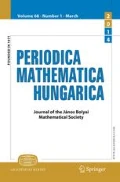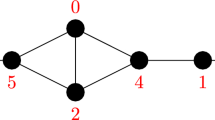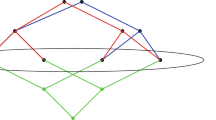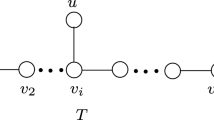Abstract
A simple graph \(G=(V,\,E)\) is said to be antimagic if there exists a bijection \(f{\text {:}}\,E\rightarrow [1,\,|E|]\) such that the sum of the values of f on edges incident to a vertex takes different values on distinct vertices. The graph G is distance antimagic if there exists a bijection \(f{\text {:}}\,V\rightarrow [1,\, |V|],\) such that \(\forall x,\,y\in V,\)
Using the polynomial method of Alon we prove that there are antimagic injections of any graph G with n vertices and m edges in the interval \([1,\,2n+m-4]\) and, for trees with k inner vertices, in the interval \([1,\,m+k].\) In particular, a tree all of whose inner vertices are adjacent to a leaf is antimagic. This gives a partial positive answer to a conjecture by Hartsfield and Ringel. We also show that there are distance antimagic injections of a graph G with order n and maximum degree \(\Delta \) in the interval \([1,\,n+t(n-t)],\) where \( t=\min \{\Delta ,\,\lfloor n/2\rfloor \},\) and, for trees with k leaves, in the interval \([1,\, 3n-4k].\) In particular, all trees with \(n=2k\) vertices and no pairs of leaves sharing their neighbour are distance antimagic, a partial solution to a conjecture of Arumugam.



Similar content being viewed by others
References
N. Alon, Combinatorial Nullstellensatz. Comb. Probab. Comput. 8, 7–29 (1999)
N. Alon, Additive Latin transversals. Isr. J. Math. 117, 125–130 (2000)
N. Alon, G. Kaplan, A. Lev, Y. Roditty, R. Yuster, Dense graphs are antimagic. J. Graph Theory 47(4), 297–309 (2004)
S. Arumugam, personal communication (2012)
M. Bača, M. Miller, Super Edge-Antimagic Graphs: A Wealth of Problems and Some Solutions (BrownWalker Press, Boca Raton, 2008)
B. Bollobás, O. Pikhurko, Integer sets with prescribed pairwise differences being distinct. Eur. J. Comb. 26(5), 607–616 (2005)
P.D. Chawathe, V. Krishna, Antimagic Labeling of Complete m-Ary Trees, Number Theory and Discrete Mathematics, Trends in Mathematics (Birkhäuser, Basel, 2002)
Y. Cheng, Lattice grids and prisms are antimagic. Theor. Comput. Sci. 374(1–3), 66–73 (2007)
Y. Cheng, A new class of antimagic Cartesian product graphs. Discrete Math. 308(24), 6441–6448 (2008)
D.W. Cranston, Regular bipartite graphs are antimagic. J. Graph Theory 60(3), 173–182 (2009)
J.A. Gallian, A dynamic survey of graph labeling. Electron. J. Comb. Dyn. Surv. # DS6 Eighteen Edition (2015)
N. Hartsfield, G. Ringel, Pearls in Graph Theory (Academic, Boston, 1994)
D. Hefetz, Anti-magic graphs via the combinatorial NullStellenSatz. J. Graph Theory 50(4), 263–272 (2005)
G. Kaplan, A. Lev, Y. Roditty, On zero-sum partitions and anti-magic trees. Discrete Math. 309, 2010–2014 (2009)
R.N. Karasev, F.V. Petrov, Partitions of nonzero elements of a finite field into pairs. Isr. J. Math. 192, 143–156 (2012)
A. Lladó, S.C. López, J. Moragas, Every tree is a large subtree of a tree that decomposes \(K_n\) or \(K_{n,\,n}\). Discrete Math. 310, 838–842 (2010)
M. Miller, C. Rodger, R. Simantujak, Distance magic labelings of graphs. Australas. J. Comb. 28, 305–315 (2003)
J. Ryan, O. Phanalasy, M. Miller, L.J. Rylands, in Combinatorial Algorithms, ed. by C.S. Iliopoulos, W.F. smyth. On Antimagic Labeling for Generalized Web and Flower Graphs. Lecture Notes in Computer Science, vol. 6460 (Springer, London, 2010), pp. 303–313
T.-M. Wang, in Toroidal Grids are Antimagic. Proceedings of the 11th Annual International Computing and Combinatorics Conference, COCOON’2005. LNCS, vol. 3595 (Springer, Heidelberg, 2005), pp. 671–679
T.-M. Wang, C.C. Hsiao, On anti-magic labeling for graph products. Discrete Math. 308(16), 3624–3633 (2008)
Y. Zhang, X. Sun, The antimagicness of the Cartesian product of graphs. Theor. Comput. Sci. 410(8–10), 727–735 (2009)
Acknowledgments
We are grateful to one of the referees for helpful comments and suggestions.
Author information
Authors and Affiliations
Corresponding author
Additional information
Mirka Miller passed away in January 2016. This paper was written during successive meetings with Mirka in Jakarta, Bandung, Barcelona and Vientiane. After a long friendship full of mathematical discussions, this is the only mathematical paper that the two of us wrote together, not knowing that it would also be the last one. It is with a mixing of happiness and sorrow that I can eventually see it in print.
Rights and permissions
About this article
Cite this article
Lladó, A., Miller, M. Approximate results for rainbow labelings. Period Math Hung 74, 11–21 (2017). https://doi.org/10.1007/s10998-016-0151-2
Published:
Issue Date:
DOI: https://doi.org/10.1007/s10998-016-0151-2




